Accepted Scientific Name: Thelocactus conothelos subs. aurantiacus (Glass & R.A.Foster) Glass
Guía Identif. Cact. Amenazadas México 1: Th/con ssp. aurantiacus (1998 publ. 1997), as 'conothele' Glass
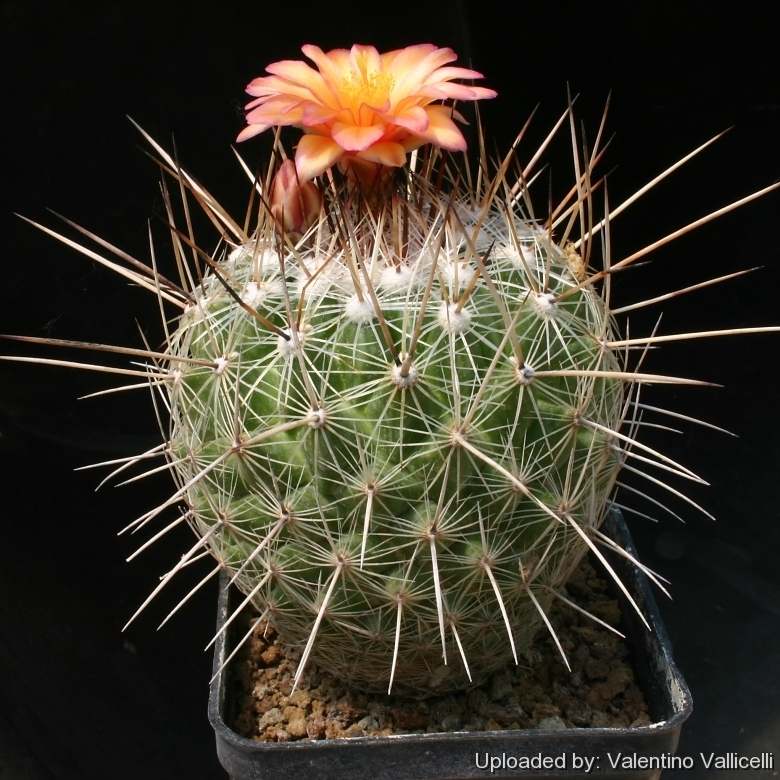
Torreycactus conothelos subs. aurantiacus (Thelocactus conothelos subs. aurantiacus) Photo by: Valentino Vallicelli
The subspecies aurantiacus, is easily recognized for its longer, glassy central spines, less densely covering the plant, and bright most unexpected and unusual yellow to orange flowers and more the colour of Parodia aureispina than any Thelocactus!
Synonyms:
See all synonyms of Thelocactus conothelos
back
Accepted name in llifle Database:Thelocactus conothelos (Regel & E. Klein bis) F.M.KnuthKaktus-ABC [Backeb. & Knuth] 358. 1936 [12 Feb 1936]Synonymy: 17
Accepted name in llifle Database:Thelocactus conothelos subs. argenteus (Glass & R.A.Foster) GlassGuía Identif. Cact. Amenazadas México 1: Th/con ssp. argenteus (1998 publ. 1997), as 'conothele'Synonymy: 4
Accepted name in llifle Database:Thelocactus conothelos subs. aurantiacus (Glass & R.A.Foster) GlassGuía Identif. Cact. Amenazadas México 1: Th/con ssp. aurantiacus (1998 publ. 1997), as 'conothele'Synonymy: 4
Accepted name in llifle Database:Thelocactus conothelos subs. flavus (Mosco & Zanov.) Mosco & Zanov.Bradleya 18: 63 (2000)Synonymy: 4
back
Description: Thelocactus conothelosSN|15121]]SN|15121]] subs. argenteus is a solitary, globose, cactus species whit with distinguishing orange blooms.
Stem: Spherical or cylindrical up to 11 cm in diameter, approx. 10 cm tall with the prominent tubercles mostly obscured by spines.
Areoles: Woolly when young, 3,5 mm wide.
Central spines: The central spines are mostly 4, porrect to slightly recurved to curving sideways, somewhat flattened, thickened creamy-white or orangish when young becoming greyish-brown and darker at base, stiff, slightly annulateand shredding with age.
Radial spines: It has about 20 glassy-silvery-greyish-white radial spines.
Flowers: The flowers are a rich bright yellow to orangey yellow in colour, margins entire.
Subspecies, varieties, forms and cultivars of plants belonging to the Thelocactus conothelos group
Thelocactus conothelos and its subspecies argenteus and aurantiacus (and also the closely related Thelocactus flavus and Thelocactus garciae) are the most different from the other Thelocacti, both for flower morphology (in these species the primary filaments are inserted 4-5 mm above the base of the nectar chamber) and for seed micro-morphology (seed testa cells are conical and the surface of the cuticle is smooth). The seed-coat micro-morphology led Doweld to propose a new genus, Torreycactus, for them.
 Thelocactus conothelos (Regel & E. Klein bis) F.M.Knuth: (ssp. conothelos) is usually solitary and globose, with tubercles not obscured by spines, and has 1-4 central spines, 10—16 radials, and magenta to white flowers. Distribution: Tamaulipas, San Luis Potosi, and Nuevo Leon.
Thelocactus conothelos (Regel & E. Klein bis) F.M.Knuth: (ssp. conothelos) is usually solitary and globose, with tubercles not obscured by spines, and has 1-4 central spines, 10—16 radials, and magenta to white flowers. Distribution: Tamaulipas, San Luis Potosi, and Nuevo Leon. Thelocactus conothelos f. albiflora hort.: has white flowers. Distribution: near Matehuala, San Luis Potosi, Mexico.
Thelocactus conothelos f. albiflora hort.: has white flowers. Distribution: near Matehuala, San Luis Potosi, Mexico. Thelocactus conothelos subs. argenteus (Glass & R.A.Foster) Glass: is solitary and globose to cylindrical, with tubercles mostly obscured by spines, and has creamy white central spines, about 20 glassy and silvery grayish white, and pinkish purple flowers. Distibution: near La Ascension, Nuevo Leon, at 2100 m.
Thelocactus conothelos subs. argenteus (Glass & R.A.Foster) Glass: is solitary and globose to cylindrical, with tubercles mostly obscured by spines, and has creamy white central spines, about 20 glassy and silvery grayish white, and pinkish purple flowers. Distibution: near La Ascension, Nuevo Leon, at 2100 m. Thelocactus conothelos subs. aurantiacus (Glass & R.A.Foster) Glass: is solitary, globose to somewhat cylindrical, with tubercles mostly obscured by spines with bright yellow to orange-yellow flowers. Distribution: Aramberri, Nuevo Leon, at 1000-1200 m.
Thelocactus conothelos subs. aurantiacus (Glass & R.A.Foster) Glass: is solitary, globose to somewhat cylindrical, with tubercles mostly obscured by spines with bright yellow to orange-yellow flowers. Distribution: Aramberri, Nuevo Leon, at 1000-1200 m. Thelocactus conothelos f. aureiflora hort.: has bright yellow flowers.
Thelocactus conothelos f. aureiflora hort.: has bright yellow flowers. Thelocactus conothelos subs. flavus (Mosco & Zanov.) Mosco & Zanov.: has strongly tubercled stems with long spines and yellow flowers. Distribution: San Luis Potosí, between Huizache and La Hincada.
Thelocactus conothelos subs. flavus (Mosco & Zanov.) Mosco & Zanov.: has strongly tubercled stems with long spines and yellow flowers. Distribution: San Luis Potosí, between Huizache and La Hincada. Thelocactus garciae Glass & Mend.-Garc.: has flattened globose stems divided into tubercles, the areoles bear one or two glands. Distribution: vicinity of Bustamante.
Thelocactus garciae Glass & Mend.-Garc.: has flattened globose stems divided into tubercles, the areoles bear one or two glands. Distribution: vicinity of Bustamante. Thelocactus longispinus: not dissimilar to Thelocactus conothelos subs. flavus but with longer spines.
Thelocactus longispinus: not dissimilar to Thelocactus conothelos subs. flavus but with longer spines. Thelocactus panarottoanus Halda: same as Thelocactus conothelos subs. flavus.
Thelocactus panarottoanus Halda: same as Thelocactus conothelos subs. flavus. Thelocactus saussieri (F.A.C.Weber) A.Berger: usually has a darker flower color, less and shorter spines and grows flatter (= less cylindrical) than the type species. Distribution: Nuevo León and Tamaulipas, Mexico.
Thelocactus saussieri (F.A.C.Weber) A.Berger: usually has a darker flower color, less and shorter spines and grows flatter (= less cylindrical) than the type species. Distribution: Nuevo León and Tamaulipas, Mexico.
Bibliography: Major references and further lectures
1) Edward Anderson “The Cactus family” Timber Press, Incorporated, 2001
2) Nathaniel Lord Britton, Joseph Nelson Rose “Cactaceae: Descriptions and Illustrations of Plants of the Cactus Family” vol. 4 The Carnegie Institution of Washington, Washington 1923
3) James Cullen, Sabina G. Knees, H. Suzanne Cubey "The European Garden Flora Flowering Plants: A Manual for the Identification of Plants Cultivated in Europe, Both Out-of-Doors and Under Glass" Cambridge University Press, 11/Aug/2011
4) David R Hunt; Nigel P Taylor; Graham Charles; International Cactaceae Systematics Group. "The New Cactus Lexicon" dh books, 2006 ISBN 0953813444, 9780953813445
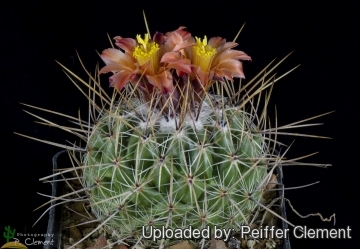 Torreycactus conothelos subs. aurantiacus (Thelocactus conothelos subs. aurantiacus) Photo by: Peiffer Clement
Torreycactus conothelos subs. aurantiacus (Thelocactus conothelos subs. aurantiacus) Photo by: Peiffer Clement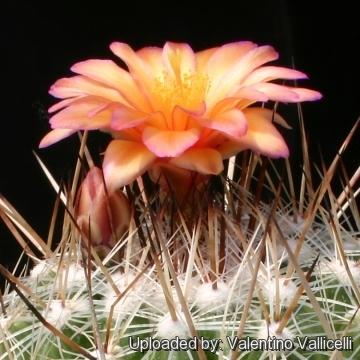 Torreycactus conothelos subs. aurantiacus (Thelocactus conothelos subs. aurantiacus) Photo by: Valentino Vallicelli
Torreycactus conothelos subs. aurantiacus (Thelocactus conothelos subs. aurantiacus) Photo by: Valentino Vallicelli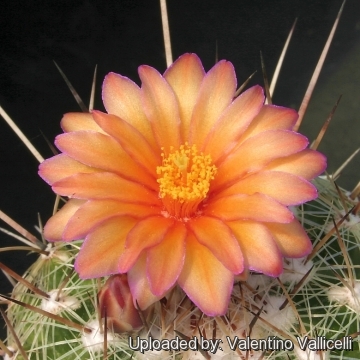 Torreycactus conothelos subs. aurantiacus (Thelocactus conothelos subs. aurantiacus) Photo by: Valentino Vallicelli
Torreycactus conothelos subs. aurantiacus (Thelocactus conothelos subs. aurantiacus) Photo by: Valentino Vallicelli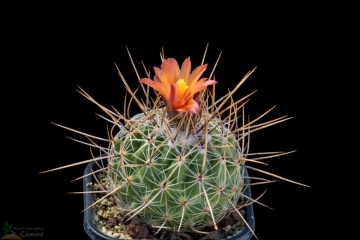 Torreycactus conothelos subs. aurantiacus (Thelocactus conothelos subs. aurantiacus) Photo by: Peiffer Clement
Torreycactus conothelos subs. aurantiacus (Thelocactus conothelos subs. aurantiacus) Photo by: Peiffer ClementCultivation and Propagation: It is a summer-growing species of relatively easy cultivation that continues to be, a particular prize among collectors. This plant is extremely xerophytic, adapted to very dry soils and is quite susceptible to over-watering if kept in a non ventilated place.
Growth rate: Slow-growing.
Soil: Grow it in an open mineral, sandy-gritty cactus compost and provide a very good drainage.
Exposure: It is suited for sunny-brightly exposure, but can tolerate light shade. However it will do its best only with lots of sun and become stressed with inadequate light which could result in poor growth and unnatural shape. It has a good heat tolerance.
Watering: Water sparingly and keep it completely dry during winter. Mature individuals easily rot and die especially after transplanting so be extremely cautious with watering. Keep dry in winter or when night temperatures remain below 10° C. Water it less than average if in bigger pots.
Fertilization: Feed them once during the growing season with a fertilizer specifically formulated for cactus and succulents (high potash fertilizer with a dilute low nitrogen), including all micro nutrients and trace elements diluted to ½ the strength recommended on the label. They thrive in poor soils and need a limited supplies of fertilizer to avoid the plants developing excess vegetation, which is easily attacked by fungal diseases.
Special need: It is suited for airy exposures. Provide very good ventilation. Nearly all problems occur as a result of overwatering and poor ventilation, especially when weather conditions are dull and cool or very humid. They must have very dry atmosphere.
Hardiness: It likes warmth (recommended minimum winter temperature 5° C) But plants kept perfectly dry can easily survive to frequent moderate frost, above approx -7° C.
Pests & diseases: These cacti may be attractive to a variety of insects, but plants in good condition should be nearly pest-free, particularly if they are grown in a mineral potting-mix, with good exposure and ventilation. Nonetheless, there are several pests to watch for:
- Red spiders: Red spiders may be effectively rubbed up by misting the plants from above.
- Mealy bugs: Mealy bugs occasionally develop aerial into the new leaves and flowers with disfiguring results, but the worst types develop underground on the roots and are invisible except by their effects.
- Scales, thrips and aphids: These insects are rarely a problem.
- Rot: Rot is only a minor problem if the plants are watered and “aired” correctly. If they are not, fungicides won't help all that much.
Propagation: Nearly always from seed, since the plant rarely produces plantlets. The seeds can be sown in pots of fine, well-drained sandy soil, any time during the spring when temperatures are warm. Cover the seeds with a fine layer of grit and water from below with a fungicide to prevent damping off. For the 1-2 weeks cover the pots with a sheet of glass/clear perspex to keep the humidity levels high. Remove the glass and replace it with light shade-cloth and mist once or twice a day for the next two weeks after which most seeds should have germinated. From then on mistings can be reduced to every second and then every third day as the little plants grow. The seedlings should not be disturbed until they are well rooted after which they can be planted separately in small pots. Sometimes it is grafted to avoid root rot problems as plants grafted on an hardy stock are easy to grow and no special skill is required.














